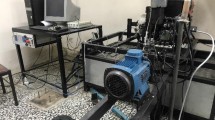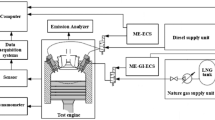Abstract
In this study, the effects of pilot injection on premixed charge compression ignition were investigated in a turbocharged diesel engine equipped with an endoscopic visualization system, and experiments were conducted under a speed of 1450 rpm at 25% and 50% loads. Results indicated that as the pilot injection mass and timing increased, the diffusion flame advanced and the flame area expanded. However, when the pilot timing advanced to 70 °BTDC, the flame luminance remained nearly constant. Moreover, with increased pilot injection mass, the peak values of in-cylinder pressure and the heat release rate of the pilot injection combustion were increased, brake-specific fuel consumption (BSFC) slightly increased, soot initially decreased but then increased, nitrogen oxide (NOX) was reduced by a maximum of 54%. The in-cylinder pressure peak value decreased with the advance of pilot injection timing, and the main combustion exhibited a lower heat release rate. Nevertheless, NOX increased significantly, and soot decreased initially but showed a slight increase at 25% load. RSM was used for finding the optimal pilot injection strategy to minimize BSFC and emissions. The optimal values found were a pilot injection timing of 50 °BTDC and a pilot injection mass of 4.4 mg for 25% load, and corresponding values of 58.9 °BTDC and 5.5 mg for 50% load.



















Similar content being viewed by others
References
Fan X, Dai J, Lu J et al (2020) Kinetic behavior evaluation of electromagnetic valve train subject to exhaust gas force. Appl Therm Eng 171:115097
Shim E, Park H, Bae C (2020) Comparisons of advanced combustion technologies (HCCI, PCCI, and dual-fuel PCCI) on engine performance and emission characteristics in a heavy-duty diesel engine. Fuel 262:116436
Singh AP, Kumar V, Agarwal AK (2020) Evaluation of comparative engine combustion, performance and emission characteristics of low temperature combustion (PCCI and RCCI) modes. Appl Energy 278:115644
d’Ambrosio S, Ferrari A, Mancarella A (2022) Time frequency analysis for the evaluation of ignition delay in conventional and PCCI combustion modes. Therm Sci Eng Prog 33:101352
Bharadwaz YD, Kumari AS (2023) PCCI combustion of low-carbon alternative fuels: a review. J Therm Anal Calorim 148(12):5179–5207
Lu Y, Fan C, Chen Y et al (2023) Effect of injection strategy optimization on PCCI combustion and emissions under engine speed extension in a heavy-duty diesel engine. Fuel 332:126053
Jia M, Xie M, Wang T et al (2011) The effect of injection timing and intake valve close timing on performance and emissions of diesel PCCI engine with a full engine cycle CFD simulation. Appl Energy 88(9):2967–2975
Zehni A, Balazadeh N, Hajibabaei M et al (2020) Numerical study of the effects of split injection strategy and swirl ratio for biodiesel PCCI combustion and emissions. Propuls Power Res 9(4):355–371
Zhang Y, Jia M, Liu H et al (2014) Development of a new spray/wall interaction model for diesel spray under PCCI-engine relevant conditions. At Sprays 24(1):41–80
Horibe N, Harada S, Ishiyama T, Shioji M (2009) Improvement of premixed charge compression ignition based combustion by two-stage injection. Int J Eng Res 10:71–80
Ge JC, Wu G, Choi NJ (2022) Comparative study of pilot–main injection timings and diesel/ethanol binary blends on combustion, emission and microstructure of particles emitted from diesel engines. Fuel 313:122658
Cao J, Leng X, He Z, Wang Q et al (2019) Experimental study of the diesel spray combustion and soot characteristics for different double-injection strategies in a constant volume combustion chamber. J Energy Inst 93:335–350
Herfatmanesh MR, Lu P, Attar MA et al (2013) Experimental investigation into the effects of two-stage injection on fuel injection quantity, combustion and emissions in a high-speed optical common rail diesel engine. Fuel 109:137–147
Qiu L, Cheng X, Liu B et al (2016) Partially premixed combustion based on different injection strategies in a light-duty diesel engine. Energy 96:155–165
Torregrosa AJ, Broatch A, García A et al (2013) Sensitivity of combustion noise and NOx and soot emissions to pilot injection in PCCI Diesel engines. Appl Energy 104:149–157
Wang J, Jin Y, Zhang YT et al (2020) Multiple injection distribution of electronically controlled injector in typical working conditions of diesel engine. Autom Eng 42(2):157–163, 177
Huang H, Huang R, Guo X et al (2019) Effects of pine oil additive and pilot injection strategies on energy distribution, combustion and emissions in a diesel engine at low-load condition. Appl Energy 250:185–197
Ehleskog R, Ochoterena RL, Andersson S (2007) Effects of multiple injections on engine-out emission levels including particulate mass from an HSDI diesel engine. SAE paper 2007-01-0910
d’Ambrosio S, Ferrari A (2015) Potential of double pilot injection strategies optimized with the design of experiments procedure to improve diesel engine emissions and performance. Appl Energy 155:918–932
Catapano F, Iorio SD, Luise L et al (2019) Influence of ethanol blended and dual fueled with gasoline on soot formation and particulate matter emissions in a small displacement spark ignition engine. Fuel 245:253–262
Xu H, Yin B, Liu S et al (2017) Visualization of combustion performance and emission characteristics of a four-cylinder diesel engine at various injection timings and engine loads. J Braz Soc Mech Sci Eng 39(10):3757–3767
Li J, Liu J, Ji Q et al (2022) Effects of pilot injection strategy on in-cylinder combustion and emission characteristics of PODE/methanol blends. Fuel Process Technol 228:107168
Hu J, Yao C, Geng P et al (2018) Effects of pilot injection strategy of diesel fuel on combustion characteristics in a premixed methanol-air mixture atmosphere in a CVCC. Fuel 234:1132–1143
Jiotode Y, Agarwal AK (2016) In-cylinder combustion visualization of Jatropha straight vegetable oil and mineral diesel using high temperature industrial endoscopy for spatial temperature and soot distribution. Fuel Process Technol 153:9–18
Huang H, Liu Q, Yang R et al (2015) Investigation on the effects of pilot injection on low temperature combustion in high-speed diesel engine fueled with n-butanol–diesel blends. Energy Convers Manag 106:748–758
Su X, Chen H, Gao N et al (2023) Combustion and emission characteristics of diesel engine fueled with diesel/cyclohexanol blend fuels under different exhaust gas recirculation ratios and injection timings. Fuel 332:125986
Xu H, Fan X (2023) High altitude performance optimization of diesel engine fueled with biodieselmethanol blends using response surface methodology. J Mech Sci Technol 37:1–9
Funding
This study is supported by the Natural Science Foundation of Jiangsu Province, China (Grant No. BK20201166), and the Graduate student innovation fund project of Jiangsu province (KYLX16_0890).
Author information
Authors and Affiliations
Corresponding author
Ethics declarations
Conflict of interest
The authors declare that there is no conflict of interest.
Additional information
Technical Editor: Mario Eduardo Santos Martins.
Publisher's Note
Springer Nature remains neutral with regard to jurisdictional claims in published maps and institutional affiliations.
Rights and permissions
Springer Nature or its licensor (e.g. a society or other partner) holds exclusive rights to this article under a publishing agreement with the author(s) or other rightsholder(s); author self-archiving of the accepted manuscript version of this article is solely governed by the terms of such publishing agreement and applicable law.
About this article
Cite this article
Xu, H., Wu, X. & Jia, H. Pilot injection impact on diesel PCCI combustion: an endoscopic study with a turbocharged engine. J Braz. Soc. Mech. Sci. Eng. 46, 76 (2024). https://doi.org/10.1007/s40430-023-04662-4
Received:
Accepted:
Published:
DOI: https://doi.org/10.1007/s40430-023-04662-4




